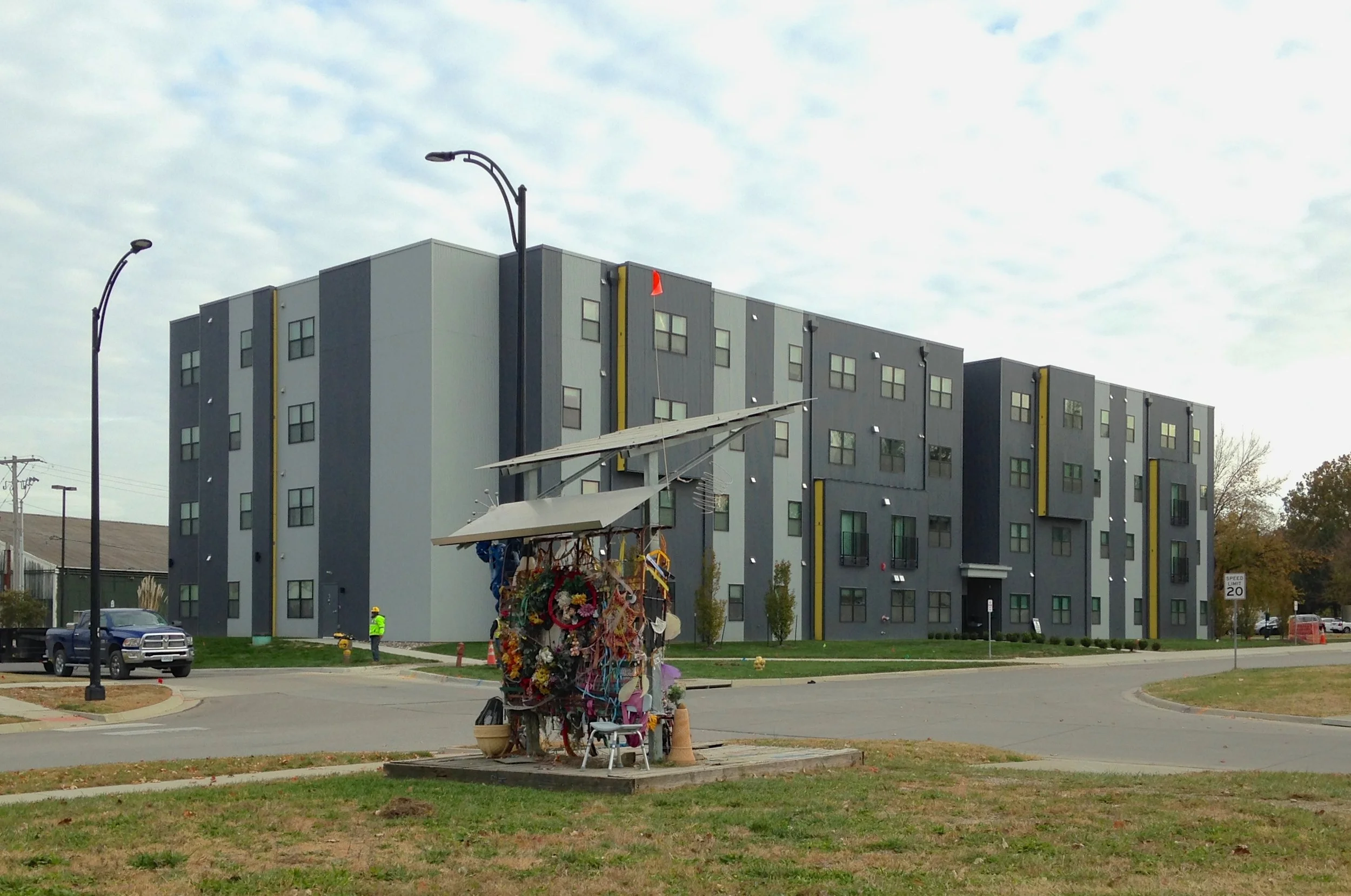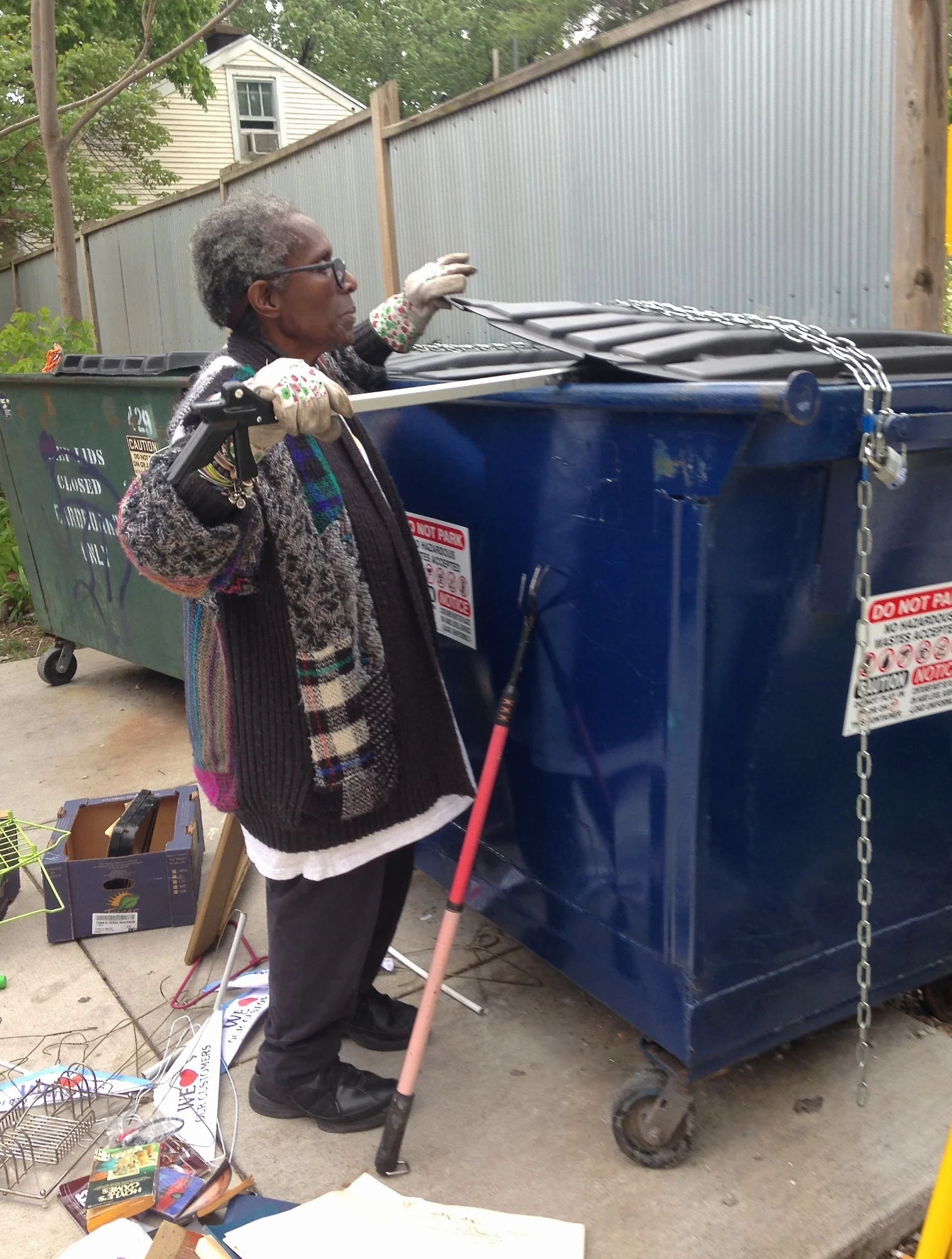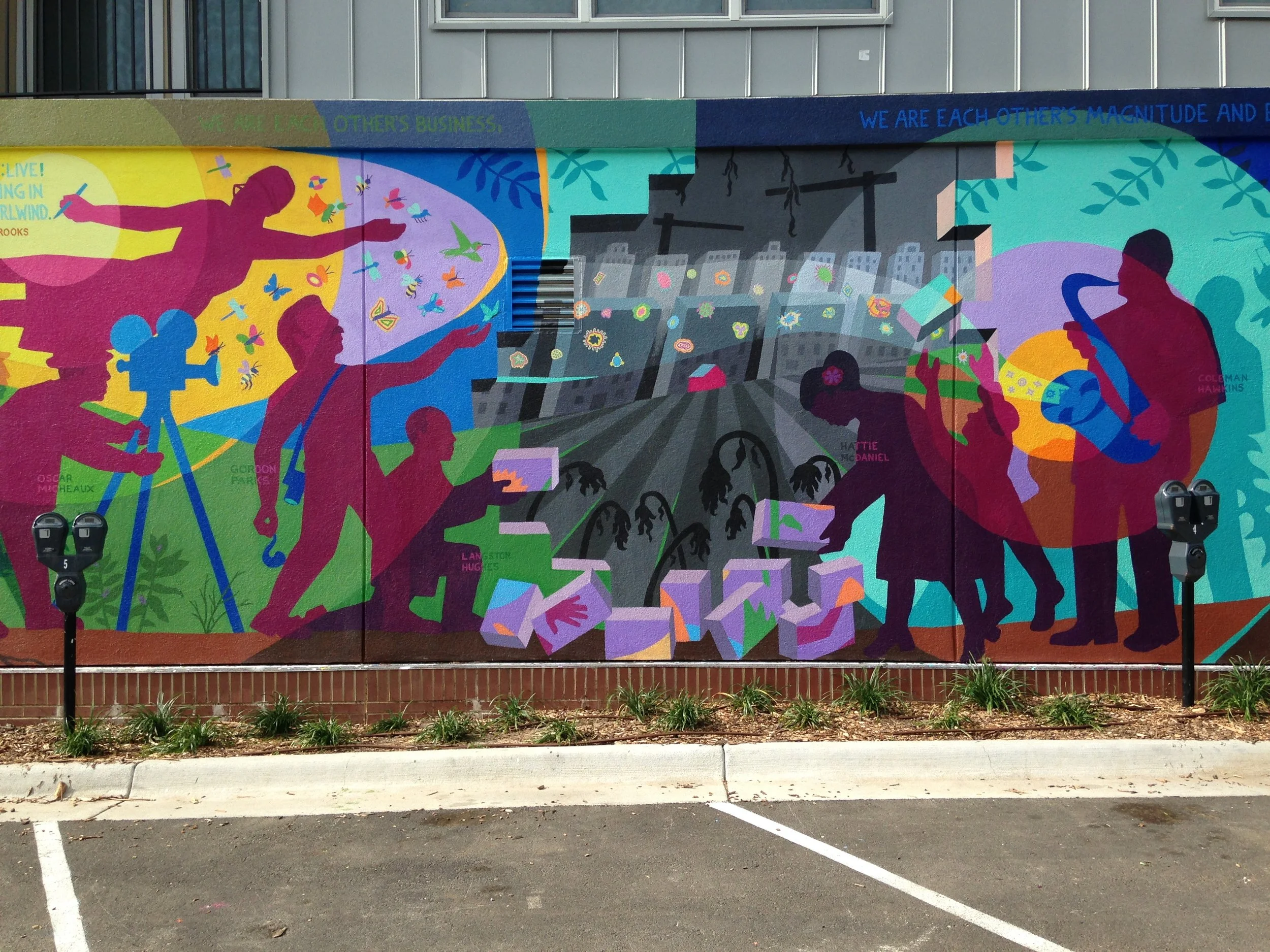The end of the Give Take Give
On a walk this fall with my three-month-old son, we took the alley past the Farmers Market parking lot toward the Social Service League. As we crossed 9th Street, I could see my friend Earline leaning into the blue metal dumpster behind the League with a homemade prospecting tool in hand. For years Earline has been collecting reusable and recyclable stuff from the dumpster. In the book documenting the project I created about the dumpster called Give Take Give she said, “I’m ready to cut back, but I don’t want to stop until I know that there’s somebody who will do it faithfully – like a job or something. Then I wouldn’t have to worry about all those hangers going to the landfill.”
Earline James at the Social Service League dumpster
But Earline was struggling, fighting to keep the lid open so she could search and retrieve, and then I realized why. There was a thick metal chain and padlock that was keeping the lid closed. This was new. It never had been locked before. My heart sank. Why would the Social Service League lock the dumpster, effectively putting an end to the gift economy it had been the center of for more than twenty years? In the days that followed, news of the locked dumpster spread, prompting the League to respond in a lengthy facebook post. They said, in part, that due to people making a mess, getting into and sleeping in the dumpster, “the lock was our only choice.” In my memory, these had never been significant issues. Only since a new board of directors and store manager were put in place did these concerns arise.
My son and I were able to walk this route because there’s a lull in construction. The alley had been closed for months, the one where the dumpster I profiled in the Give Take Give project is, and the one adjacent to the Pollinators mural I helped create at Farmers Market. In the last few years, this two-block stretch of New Hampshire St. has been transformed. There are more than one hundred new upscale apartments, a rooftop pool, a Marriott Extended Stay hotel, an expensive wine shop, and a foodie bistro. Looking west from Rhode Island Street, this wall of new five to eight story buildings looms over the houses below them, and stands as a visual and psychological divide between downtown and East Lawrence - on one side, a burgeoning neo-yuppie enclave, on the other side, a historic working-class neighborhood.
East 9th Street looking south between New Hampshire and Rhode Island
Many in East Lawrence opposed these new developments or at least wanted them to be smaller, scaled closer to the aspect of the rest of the neighborhood. And it was this coming wave of construction, and the potential it had to impact the social fabric of the neighborhood, that led me to begin the Give Take Give project. I feared that if the story of the dumpster’s unique gift economy wasn’t captured then, it might be lost forever.
At the end of Give Take Give, I wrote, “Hopefully, this book will not become a nostalgic elegy for something that was. Hopefully, the give take give at the League dumpster continues on where it’s always been.” That was four years ago. The dumpster is still there, but as Andrés and I discovered, now it’s just for trash, locked out of the current of good will that sustained the give take give.
Blowing-up the neighborhood
Changes at the Social Service League are part of an economic and aesthetic revitalization push evidenced by the new building projects spreading out from the intersection of New Hampshire & East 9th Streets and a growing desire among some to see this "corridor" as ripe for Placemaking.
Placemaking is a development tool broadly describing the use of art and artists to increase the economic and social potential of an area often deemed blighted or undervalued. Although it is supported in the field of community development, there is growing body of criticism about Placemaking and how it can contribute to the process of gentrification.
All of this demolition and construction led to talk about whether nearby East 9th Street was about to “Blow-up.” Tourism bureaus and hipsters like to announce that a place is about to "Blow-up" when a formerly uncool (usually working-class) neighborhood sees the influx of foodie food trucks, art galleries and lofts. Lofts!
Ruins of the original Pollinators mural
For a place to really Blow-up, developers often recommend making the desired neighborhood “safer,” so that visitors feel comfortable around the new breweries and coffee shops. This of course is code language aimed at potential investors and real estate speculators signaling that they should get in while they can. And like other redevelopment schemes from the past (urban renewal and manifest destiny to name a couple) a neighborhood that gets blown-up often sees the replacement of established residents and businesses with new ones - in other words gentrification.
Return of the Pollinators
A block north of the Give Take Give dumpster, the original Pollinators mural had already fallen victim to this vision. It was taken down to make room for the new 888 Lofts and rooftop pool, which, no joke, was first occupied by a KU fraternity. Adding irony to this loss was that Pollinators was being demolished at the same time the City was touting its first cultural arts district (which included the Pollinators). This was not lost on neighbors, many of whom saw it as a sign that all the talk of Placemaking was just a way of making the greater goal of upscale development more palatable.
Fortunately, we had some warning about the Pollinators’ fate and were able to organize a response. Although there was no city, state or federal protection for the mural we could point to, love and support for the mural was widespread and folks were not going to accept its destruction as the inevitability of "progress."
After months of negotiation, and with the support of hundreds of Lawrencians, the developer agreed to fund the creation of a new mural in roughly the same place as the original on the new building. That mural, completed in July, pulls no punches. The design team I led was determined that we tell the story of what happened to the original and address the threat posed by the forces that took it down. But I wonder, as I did with the dumpster, if the new mural will become just another elegy, an artifact from a battle lost to gentrification.
Detail from the Return of the Pollinators
In Lawrence, like many cities, when large building or road projects are proposed they must go through a number of reviews including an Environmental Impact Study. This ensures that the proposed activity will not unduly harm protected animals, habitats or public health. We have no review however for how such projects can adversely affect cultural fabric - the ways in which groups of people maintain and practice their culture, including expressions of heritage, language and social gathering. Writer Arlene Goldbard thinks we should. She imagines communities adding a Cultural Impact Study to the review process to make certain that harmful impacts can be addressed and alternatives explored. Proposing such a study, I believe, would start a needed and new conversation about how we imagine Lawrence and what we value as a community.
Three Wishes
On our way home, my son and I walked east along 9th Street past the Turnhalle, past the old Kansas Key Press, past where Rick “Tiger” Dowdell was shot and killed by police, past St. Luke AME, past the community orchard, and all the while on the traditional lands of indigenous peoples including the Kansa, Ioway and Osage, until we got to one of the most improbable and beloved spots in town. It’s known locally as the Wishing Bench - a place not unlike the League dumpster in spirit (pre-lock and chain), where a current of wishes asked for and granted flows through.
The bench, which began as a KU class project, over time has become an improvised community artwork and Lawrence icon with a simple purpose inscribed on a hand painted sign added to its frame. It says, “Sit and make a wish. You won’t be disappointed.” It’s free, unsupervised and since it’s not owned by anyone but sits on the property of an ambitious developer, it’s vulnerable, like a canary in a coalmine. My son was captivated by all of the colors and shapes, the things people had added over the years, which turned the cold metal structure into a kind of shrine to the hopes and dreams of the neighborhood. We sat, and granted ourselves three wishes. He went first (It was something that ended in a ear piercing high-pitched laugh and drool), me next (If I tell, it won't come true) and the last wish we gave back to the wishing bench, cautiously optimistic that it would be undisappointing those who shared their secrets for many years to come.






